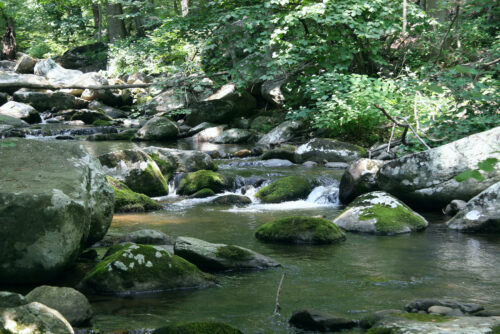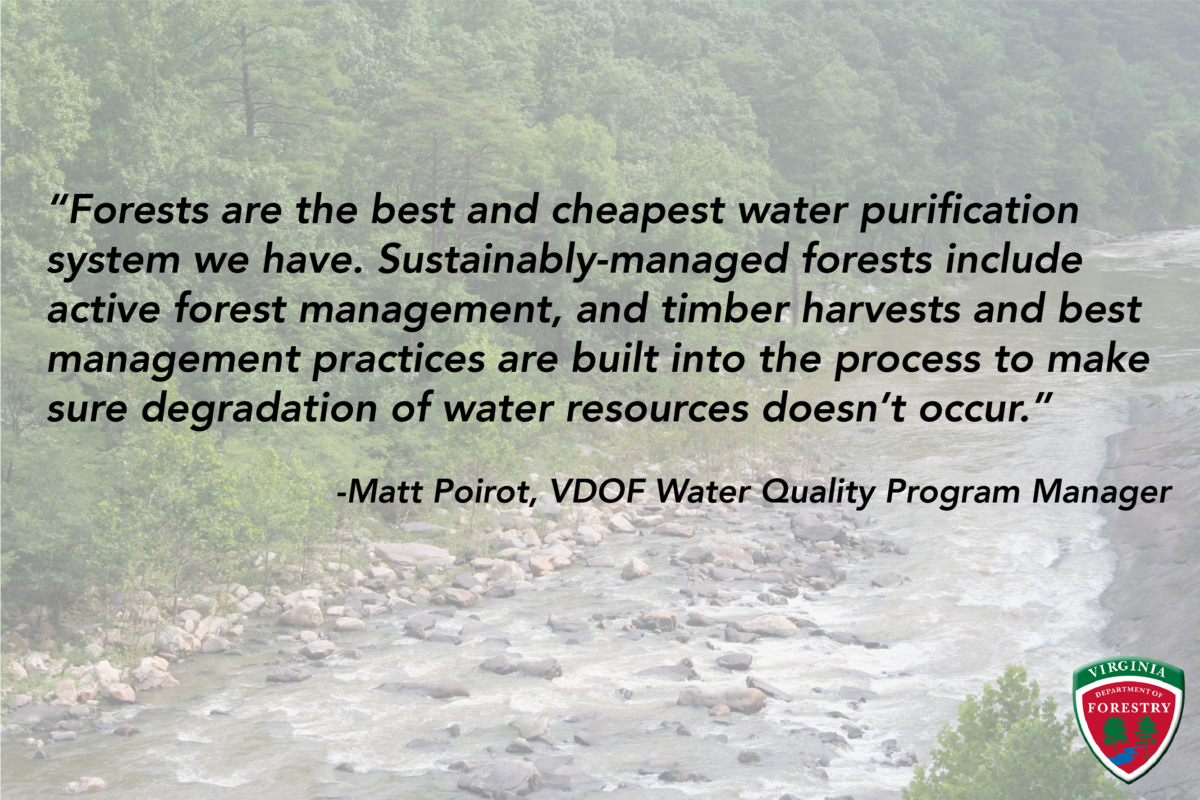Forestry for Water Quality
June 11, 2020 4:00 pm

The results are in, and the 2019 annual Silviculture Best Management Practices (BMP) Implementation Monitoring Report shows that the logging industry and timberland owners continue to excel at protecting Virginia’s water resources. Forests are essential to clean, healthy drinking water and watersheds, and sustainably-managed forests are the most effective land cover for protecting water quality.
Forests improve air quality, provide wildlife habitat, and supply clean water, all while producing the resources for products we use every day – from furniture and lumber for our homes, to soap for washing our hands, for medicines and hygiene, to filters for our morning coffee.
In the bigger picture, forests and forest products are key in our collective response to climate change, by providing carbon sequestration from seedlings to decomposition. Wood is also recyclable, and a renewable alternative to one-use materials; so, if you want to see less plastic waste in our landfills and waterways, supporting forest products is the place to start.
Because forest products are essential to our sustainable future, supporting the industry and forest landowners who maintain more than 60 percent of forests in Virginia is crucial. For these forest owners, forest management and the resulting timber harvests are vital to provide the revenue needed to maintain their ownership and provide ecosystem benefits that all citizens enjoy.

Protecting the environment is paramount to these activities, and Virginia is proudly one of the only states in the nation that conducts on-the-ground inspections of every logging job site to ensure our waterways are protected during logging operations. Virginia’s timber harvest water quality program involves the voluntary implementation of Best Management Practices (BMPs) backed up by the Silvicultural Water Quality Law.
Here’s the great news: year after year, Virginia’s logging community does a tremendous job protecting our waterways through voluntary implementation of BMPs.
VDOF has been monitoring and protecting water quality at timber harvest sites for more than 25 years (following the Southern Group of State Foresters protocol for the past 12 years). Thousands of harvest sites and substantial acreage are represented in these field inspections each year. During the 2019 state fiscal year, VDOF personnel inspected 4,404 timber harvest sites across the Commonwealth during 17,986 site visits, covering 198,306 acres.
Every year, VDOF conducts an audit of 240 logging sites across Virginia during the three- to six-month period following the timber harvest and produces an annual report of results, known now as the Silviculture BMP Implementation Monitoring Report. This year’s results show that 95 percent of the applicable BMPs had been implemented statewide with a 97 percent BMP implementation rate on harvests within the Chesapeake Bay watershed. None of the sites visited statewide exhibited any active sedimentation impacting Virginia’s water.
Read the Report: Silvicultural Best Management Practices Implementation Monitoring for Virginia
“These numbers are telling us that the logging workforce and forestry community are implementing practices that protect water quality. We are not seeing sedimentation – this tells us that water quality is being protected,” says Matt Poirot, VDOF’s water quality program manager.
Water quality protection is a component of many forest sustainability certification programs – timber companies are scored on their application of BMPs if they pursue certification, a standard which is becoming increasingly important to end consumers who value sustainable, healthy forests.

Our logging community recognizes that the public has high expectations of them, and they appreciate the importance of protecting all forest resources, including wildlife habitat and clean drinking water. They take these responsibilities seriously and demonstrate their commitment by voluntarily implementing BMPs. “Loggers are doing an exceptional job,” says Poirot. “I have nothing but praise for them. They’re consistently doing the right thing and bearing the costs of these efforts.”
“Forests are the best and cheapest water purification system we have. Sustainably-managed forests include active forest management, and timber harvests and BMPs are built into the process to make sure degradation of water resources doesn’t occur,” says Poirot.
It’s perhaps most important to remember that by supporting working forests, we are supporting the private forest landowners and ensuring that forestland remains intact and able to perform essential ecosystem services for society. The trees that are removed as part of sustainable forest management are replaced by new trees and the land remains as forestland. The regeneration and reforestation practices following the harvest means the continuation of the forests we love and all the benefits they provide to our Commonwealth.
Tags: Best Management Practices, Chesapeake Bay, Logger Resources, Riparian Forest Buffers, Water Quality
Category: Water Quality
